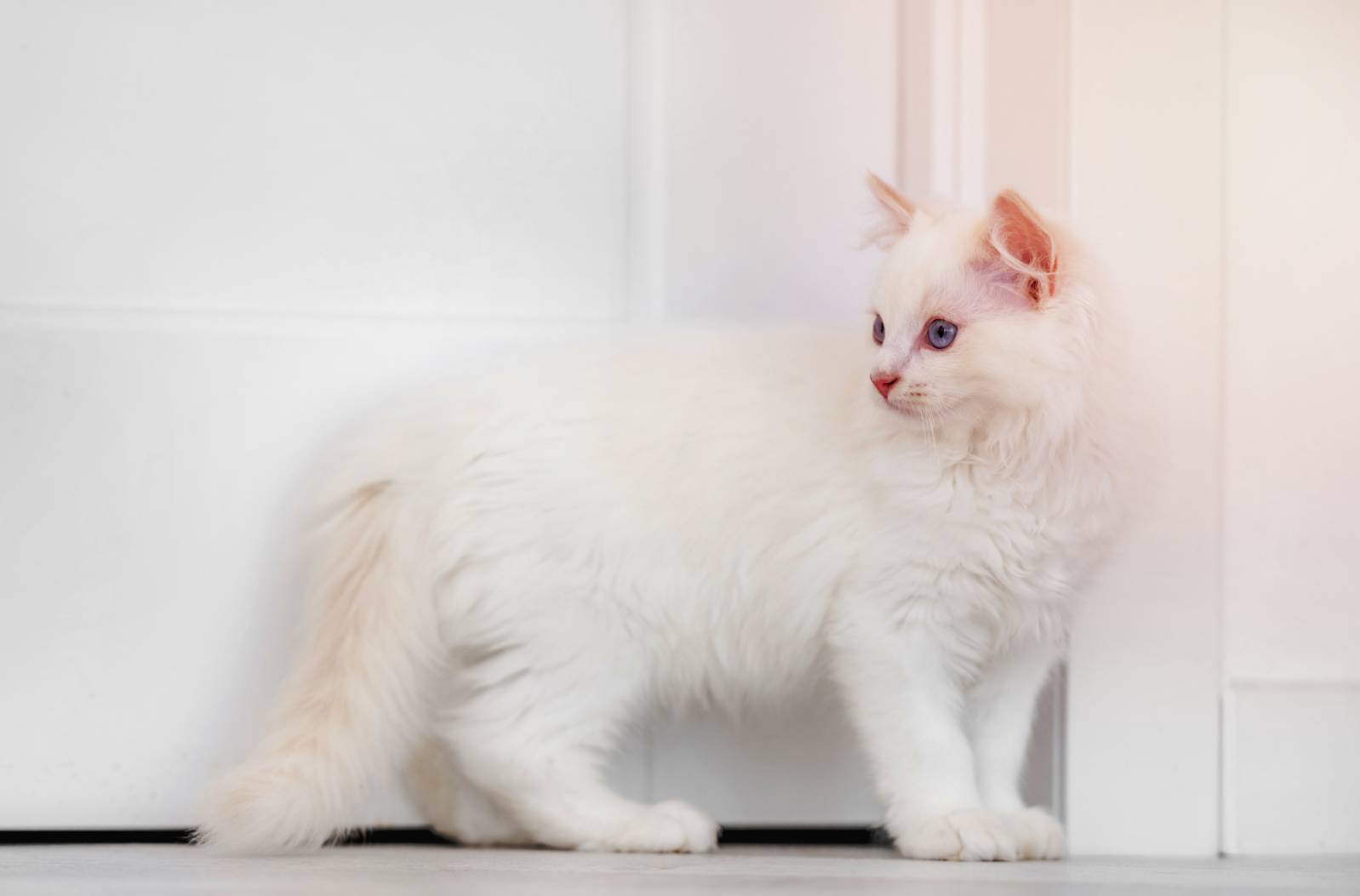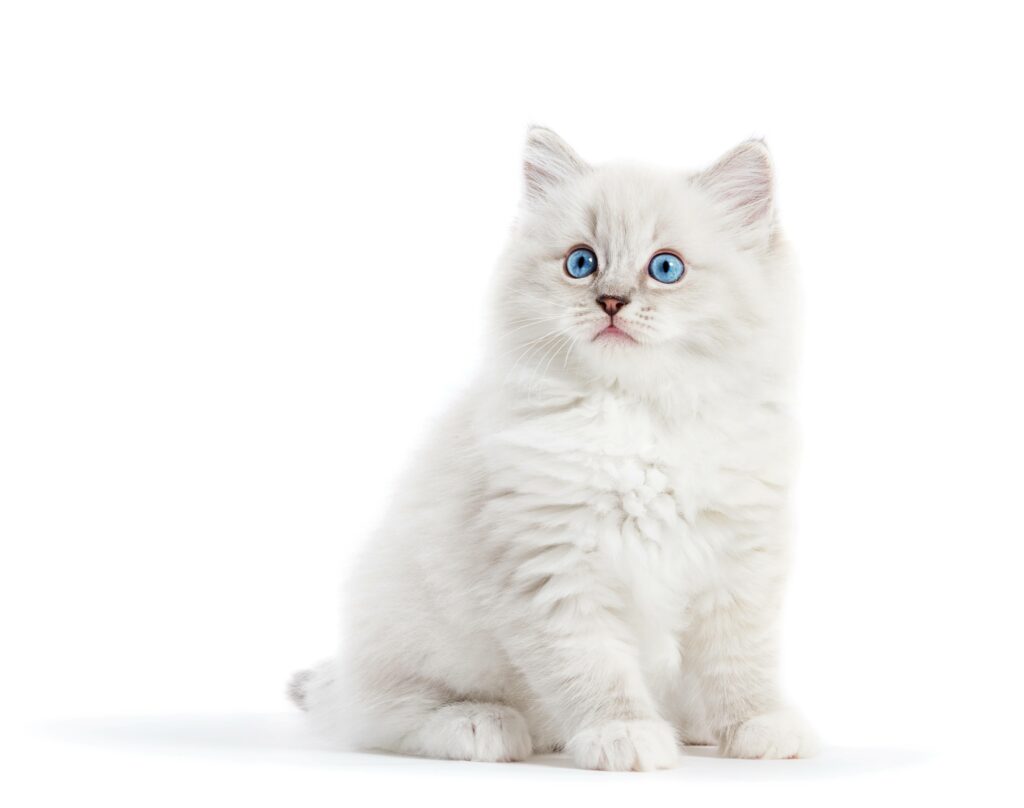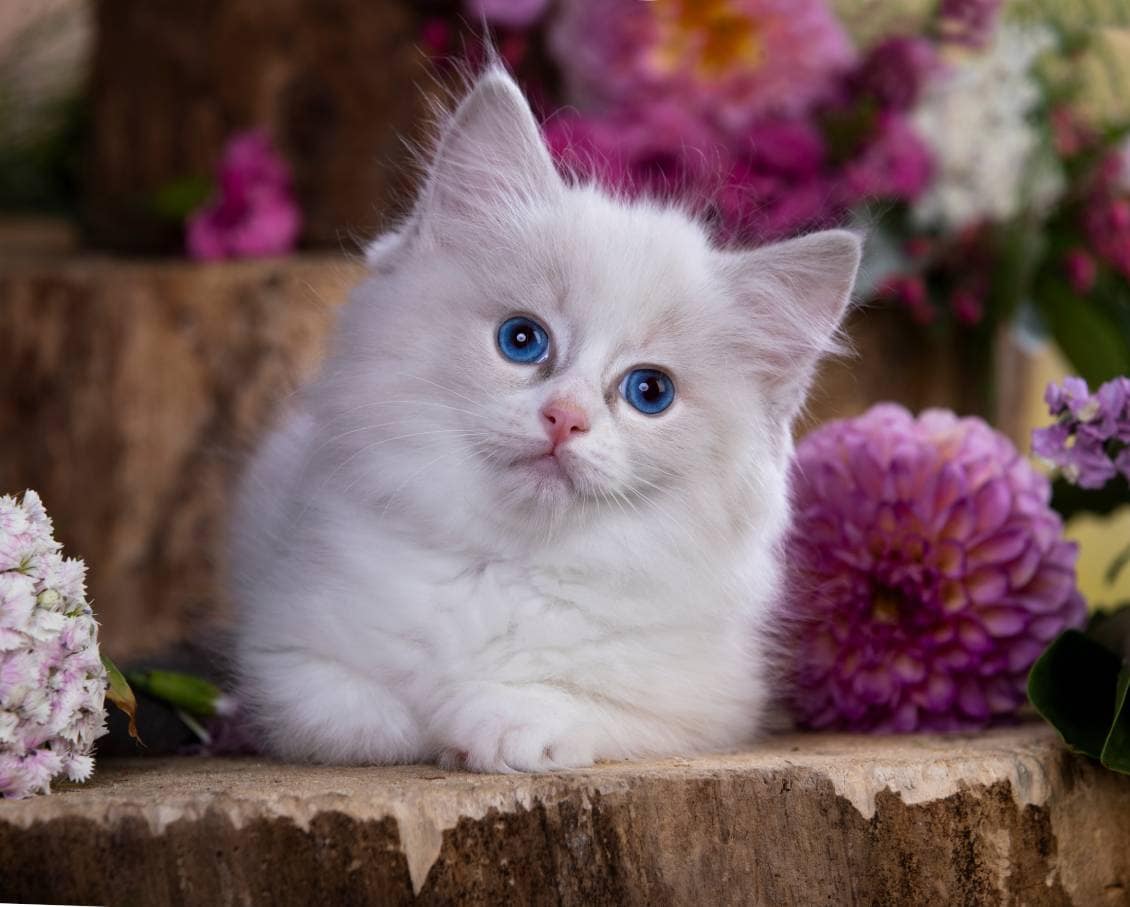- April 27, 2024
White Ragdoll Cat: Facts, History & Origin (With Pictures)

Ragdoll cats are easily one of the most popular cat breeds in the world. These long-haired cats are social, loving, and great with people. This breed does well with children and even other pets like dogs. Ragdolls are beautiful kitties that are front and center of a bit of controversy. What controversy can cats be a part of, you may ask? Oddly enough, it all has to do with coloring.
Breed Overview
Suitable for:
Anyone who wants a cuddly cat!
Temperament:
Docile, cuddly, loyal
Since Ragdolls were formally recognized, certain traits and appearances have been the standard. When it comes to colors, the Ragdoll standard is a pointed cat. This means the body is meant to be lighter in color than the face. The only recognized Ragdoll colors are seal, chocolate, blue, flame, lilac, and cream. Unfortunately, white isn’t on the list. But does that mean white Ragdolls don’t exist? The answer is no one really knows. There are white cats that resemble and act like Ragdolls that some consider pure breeds, but there are societies and breeders who say no.
Characteristics
Energy
+
A high-energy cat needs a lot of physical and mental stimulation to keep healthy and happy, while a low-energy cat needs minimal physical activity, but still needs mental stimulation. When choosing a cat, It’s important to ensure their energy levels match your lifestyle.
Trainability
+
Cats that are easy-to-train are more willing and skilled at quickly learning prompts and actions with minimal training. Harder-to-train cats are usually more stubborn or aloof and require a bit more patience and practice.
Health
+
Certain cat breeds are more prone to various genetic health problems, and some more than others. This doesn’t mean that every cat in those breeds will have these issues, but they do have an increased risk, so it’s important to understand and prepare for any additional needs they may require.
Lifespan
+
Due to their size or potential genetic health issues of a specific breed, some cats have shorter lifespans than others. Proper nutrition, exercise, mental stimulation, and hygiene also play an important role in your cat’s lifespan and quality of life.
Sociability
+
Some cat breeds are more social than others, both towards humans and other cats and animals. Cats that are more social have a tendency to rub up on strangers for scratches or jump on laps for cuddles, while cats that are less social shy away, hide, are more cautious, and even potentially aggressive. No matter the breed or gender, it’s important to socialize your cat and expose them to many different situations.

The Earliest Records of White Ragdoll Cats in History
It’s difficult to pinpoint when the first white Ragdoll appeared in the breed’s history. What we do know is that the history surrounding Ragdolls is somewhat strange. There are at least two stories associated with this breed, with no one truly knowing which is true. What we do know for sure is that we can thank a woman named Ann Baker for the precious breed we know today.
In the early 1960s, Ann was a breeder of Persian cats who lived in Riverdale, California. One of Ann’s cats was named Josephine. Some stories claim Josephine, a white Angora cat, was a rescue in Ann’s care while others claim she and her offspring were borrowed as part of the breeding program. Either way, all Ragdolls can trace their heritage back to Josephine. It is believed that Josephine was bred with a Birman to produce the first Ragdoll kitties. Over the years, Ann worked to create the Ragdoll breed and enhance the traits she wanted to include.
How White Ragdoll Cats Gained Popularity
Ragdolls became extremely popular in society fairly quickly. The unique beauty and habit of falling limp like a ragdoll when being held made people want them as part of their families. White Ragdolls, however, were always viewed as a myth or fake Ragdolls by certain breeders and societies. Recently, the International Cat Association began accepting white Ragdolls as pure breeds. This has helped these rare kitties gain popularity ever since.

Formal Recognition of White Ragdoll Cats
The Ragdoll breed was formally recognized by The Cat Fanciers Association in 1966 when Ann Baker officially registered her breed. When it comes to white Ragdolls, however, the CFA does not recognize them as purebred Ragdolls. However, in recent years, the International Cat Association has begun accepting white as a part of the Ragdoll breed standard.

Top 3 Unique Facts About White Ragdoll Cats
1. An Accident Could be the Reason Ragdolls Got Their Name
There are several stories surrounding the origins of Ragdolls. One such story has to do with Josephine, the mother of the breed, and an accident. Is claimed that Ann Baker’s cat Josephine was injured in an accident where she was hit by a car. After the accident, the mother of the breed was unable to feel pain and would flop in her owner’s arms like a ragdoll when she was picked up.
2. All Ragdolls Are Born Without Color in Their Coat
With such a huge controversy over what colors are accepted as breed standards for the Ragdoll, it’s odd to realize kittens of this breed are born without any coloration. The pigment comes in as the cats’ age. Most Ragdolls don’t reach their true coloration until they are around 2 years old.
3. Cream Colored Ragdolls Are Ultra Rare
With white Ragdolls not being accepted by so many, that leaves cream Ragdolls as the rarest ones out there. Roughly 3% of Ragdoll owners are lucky enough to have one of these uniquely colored kitties in their home. A cream Ragdoll has a white body with ivory points around the face. Often, people confuse these cats with pure white Ragdolls.

Does a White Ragdoll Cat Make a Good Pet?
Whether they are white, cream, or any accepted color, Ragdolls make excellent pets. These cats are very even-tempered, loving, and family oriented. Ragdolls enjoy spending time with their families and can even be taught tricks due to their high intelligence. Whether you have children or other pets, a Ragdoll can be the perfect kitty addition to any family.


Conclusion
With the controversy surrounding white Ragdoll cats, it’s difficult to say whether the coloration is real or not. Certain breeders and cat associations have opened their arms to the possibility of a solid-colored Ragdoll while others haven’t. Either way, you cannot deny the beauty and temperament of these amazing cats. If you have the chance to welcome one into your home, you definitely should.
Featured Image Credit: cataliniturca Shutterstock
Tags
What do you think?
Related Articles

New Puppy Checklist: Gear You’ll Need for Your New Dog
Getting a new puppy is really exciting, but before you welcome them home, it’s important to prepare your space for them. Since puppies need a

How Big Do Mini Poodles Get? Vet Reviewed Average Weight & Growth Chart – Dogster
The information is current and up-to-date in accordance with the latest veterinarian research. Learn more » When you buy a Miniature Poodle, you might not

Can Police Dogs Smell Nicotine? Vet Verified Facts & Info – Dogster
The information is current and up-to-date in accordance with the latest veterinarian research. Learn more » While cigarette sales have been declining steadily for decades,

How Old Is 5 in Dog Years? Vet-Approved Guide to Each Size of Dog – Dogster
The information is current and up-to-date in accordance with the latest veterinarian research. Learn more » A common method for calculating a dog’s age is

